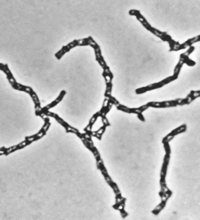Pelodictyon phaeoclathhratiforme is a green sulfur bacterium frequently observed in stratified freshwater lakes where light reaches sulfide-containing water layers (1, 2). The type strain (BU 1 = DSM 5477) was isolated from water samples of a meromictic lake in 1989 (3). The cells are Gram-negative, non-motile, 1.5 - 3 µm long and 0.75 - 1.1 µm wide. The rod-shaped cells are often trapezoid in shape and form characteristic net-like colonies by ternary fission. Like all the other green sulfur bacteria, this species is strictly anaerobic and obligately phototrophic. Photosynthetic pigments comprise mainly bacteriochlorophyll e and isorenieratene/b -isorenieratene plus small amounts of bacteriochlorophyll a. Sulfide, sulfur and thiosulfate are used as electron donors during anaerobic phototrophic growth. In contrast to most other isolates of green sulfur bacteria, growth of pure colonies was found to be strictly dependent on the addition of dithionite, indicating that Pld. phaeoclathratiforme requires strongly reducing conditions for growth. Besides carbon dioxide, acetate and propionate serves as carbon sources under mixotrophic conditions in the light. The guanine plus cytosine content is 47.9%. Together with the morphologically similar, green-colored Pld. clathratiforme, Pelodictyon phaeoclathratiforme forms a distinct phylogenetic lineage within the radiation of green sulfur bacteria (4). Pelodictyon phaeoclathratiforme frequently represents the dominant green sulfur bacterium in its natural habitat (1, 2, 3). This may be related to its most peculiar features, the formation of net-like microcolonies and of intracellular gas vesicles. Ternary fission, which leads to the formation of ring-shaped and branched colonies, is observed at growth-limiting light intensities (2). Gas vesicles are hollow rigid structures which occur only in prokaryotic cells. The proteinaceous vesicle membrane is impermeable to liquid but permeable to gases. Because of their gas content, gas vesicles decrease the density of the cell and may provide neutral or even positive buoyancy if present in sufficient amounts. Like ternary fission, gas vesicles are exclusively observed in cells grown at light intensities below 5 µmol photons m-2 s-1 , whereas growth temperature or nutrient limitation have no effect (5). Regulation of cell density at low light intensities is accomplished by the induction of gas vesicle formation, the decrease in cellular carbohydrate content, and an increase in cellular volume, most likely mediated by an increase in extracellular slime layers. Together, these processes lead to a minimum buoyant density of the cells which corresponds to the density of the surrounding water (5). Unlike some cyanobacteria, cells of Pld. phaeoclathratiforme do not attain positive buoyancy and thus are unlikely to rise to the lake surface and to leave their habitat. Gas vesicles of Pld. phaeoclathratiforme are comparatively stable and collapse at pressures of > 485 kPa. Since the turgor pressure of the cells reaches only 330 kPa, a short-term increase in cell density by the turgor pressure mechanism similar to some cyanobacteria can be excluded (5). The capability of buoyant density regulation offers one explanation for the dominance of Pld. phaeoclathratiforme in many stratified lakes. Ternary fission and the regulation of gas vesicle content also occur in other bacteria outside of the phylum green sulfur bacteria. Because Pld. phaeoclathratiforme exhibits only little physiological flexibility, genome sequencing of this bacterium offers the opportunity to study the molecular basis of these two particular processes in a comparatively simple model organism. References(1) Overmann J., Tilzer M.M. (1989) Control of primary productivity and the significance of photosynthetic bacteria in a meromictic kettle lake. Mittlerer Buchensee, West-Germany. Aquatic Sciences 51 , 261-278 (2)Overmann, J., Garcia-Pichel, F. (2000) The Phototrophic Way of Life. In : Dworkin, M. et al. (eds.) The Prokaryotes: An Evolving Electronic Resource for the Microbiological Community, 3 rd edition (latest update release 3.11, September 2002), Springer, New York, 2000 (http://ep.springer-ny.com:6336/contents/ ) (3) Overmann J., Pfennig N. (1989) Pelodictyon phaeoclathratiforme sp. nov., a new brown-colored member of the Chlorobiaceae forming net-like colonies. Arch. Microbiol. 152 , 401-406 (4) Overmann, J., Tuschak, C. (1997) Phylogeny and molecular fingerprinting of green sulfur bacteria. Arch. Microbiol. 167 : 302-309 (5) Overmann J., Lehmann S., Pfennig N. (1991) Gas vesicle formation and buoyancy regulation in Pelodictyon phaeoclathratiforme (Green sulfur bacteria). Arch. Microbiol. 157 , 29-37
|
||
|
||
Pelodictyon phaeoclathratiforme BU-1

